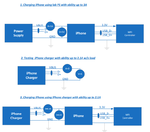stanislavb
Full Member level 2
Hi,
Does any body know how to use iphone charger as PS supply with ability provide 1A.
Currently it provides not more than 300mA only. However charger specification is 1.5A...
Thank you
Does any body know how to use iphone charger as PS supply with ability provide 1A.
Currently it provides not more than 300mA only. However charger specification is 1.5A...
Thank you
